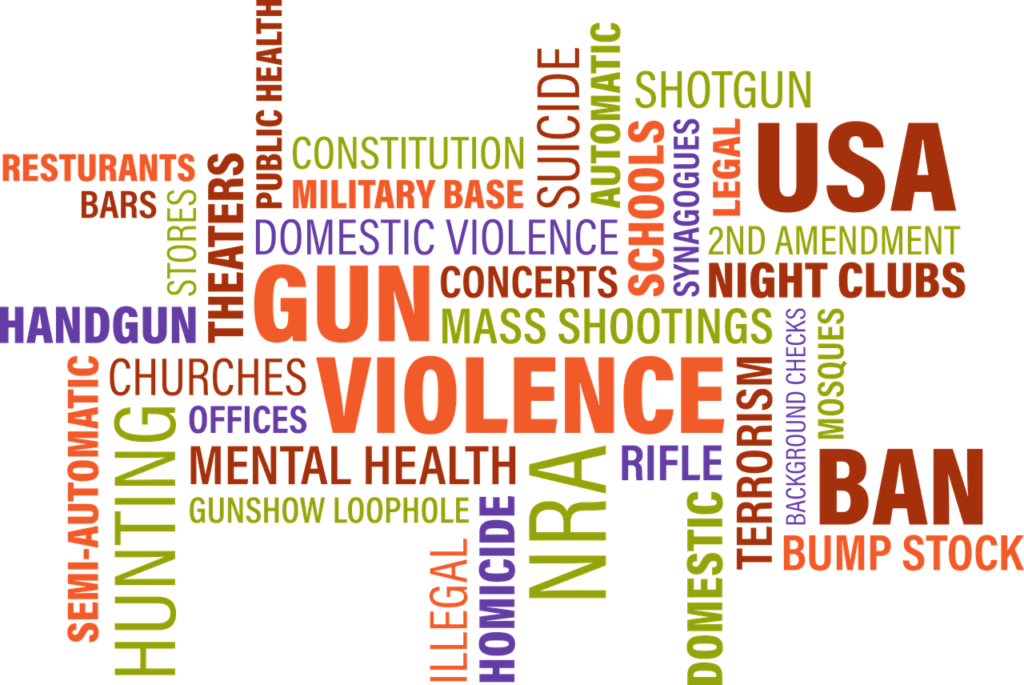
In this final article of the series, we apply the results of a deep dive into gun violence and mass shootings to come up with a set of common ground solutions. Instead of unacceptable gridlock fomented by hyper-partisan narratives and positions, we’ll identify common interests that can serve as the basis for solutions. As much as possible, our quest is to develop a set of solutions based on consensus—solutions that most Americans could support, accept, or tolerate.
What Are Our Common Interests?
Based on our deep dive, here is an attempt to identify the common interests that Americans share regarding gun violence and mass shootings:
- Americans have a common interest in greatly reducing—if not eliminating—gun violence. We do not want mass shootings, suicide by gun, accidental shootings, or guns used in the commission of crime.
- Americans have a common interest in withholding or taking away guns from those who present a danger to themselves or others. In order to identify and focus on people who present a danger to themselves or others, we recognize the necessity of having systems or processes that will screen all purchasers or gun possessors to determine whether or not they present such a danger.
- Americans have a common interest in respecting the 2nd Amendment rights of citizens who are law-abiding and who do not present a danger to themselves or others. We do not want to take away guns from these Americans, but instead want to focus on taking away guns from people who present a danger to themselves or others.
- Americans have a common interest in ensuring action is taken to reduce gun violence. Gun violence, mass shootings, deaths, and injuries are all increasing. Americans do not want to remain thwarted by partisan gridlock and inaction as the situation worsens. Rather, we have a common interest in adopting common ground solutions that are either supported, accepted, or tolerated by most Americans. It also follows that Americans have a common interest in holding their elected representatives accountable to take action to reduce gun violence.
- Americans have a common interest in ensuring that gun laws be reviewed and improved over time. Tens of thousands of gun laws have been adopted at the federal, state, and local levels. In particular, the states have taken very different approaches. Americans have a common interest in ensuring that these laws are studied and reviewed using evidence-based approaches. Revisions should be made reduce to gun violence and maintain consistency with the 2nd Amendment.
What Are Potential Common Ground Solutions?
As a part of our deep dive, we identified numerous potential solutions to address the multi-faceted problems of gun violence. Let’s come back to these solutions and identify those that meet all or some of our common interests. Let’s also include the degree of public support for such solutions as measured by public opinion surveys.
1. Federal Law requiring background checks for all gun sales:
Federal gun laws still exempt unlicensed sellers—people who sell guns online, at gun shows, or anywhere else without a federal dealer’s license—from having to perform any background check whatsoever before selling a firearm. While some states have acted to close this loophole, most have not. An estimated 22% of gun owners have acquired their most recent gun without a background check.
Federal law doesn’t require states to make information identifying people ineligible to possess firearms available to the federal or state agencies that perform background checks. Thus, many states fail to report the records to the appropriate databases. In such cases, the search on a background check can omit critical information, including: criminal history records, mental health records, drug abuse records, and domestic violence records. As a result, individuals known to pose a serious risk to themselves and others can pass background checks and obtain firearms.
Finally, while most background checks can be completed in a matter of minutes, some require further investigation and are expected to be completed within three business days. If not completed within this time, the firearm dealer is usually authorized to complete the sale and delivery under the federal “default proceed” rule. Unfortunately, this rule is annually allowing thousands of prohibited purchasers to buy guns before their background check is completed.
Changes in federal law to require background checks for all gun sales, including improvements in reporting by states, and allowing more time for certain checks are all solutions to do a better job of assuring that guns are not acquired by people who present a danger to themselves or others. In a recent Gallup Poll, 92% of respondents favored “requiring background checks for all gun sales.”
2. Federal law encouraging all states to pass “red flag” (extreme risk laws):
Extreme risk protection laws authorize law enforcement agencies, family members, household members, or others to petition courts for a civil (non-criminal) order that temporarily suspends a person’s access to firearms before they commit violence. Extreme Risk Protection Orders (ERPO’s) are an essential addition to background check and firearm restriction laws because they allow the courts, through a specific risk-based assessment process, to temporarily disarm a person found to be an extreme risk of violence but who otherwise would be able to pass a background check and acquire weapons. ERPO’s can be used to prevent a non-gun owner from acquiring firearms, or to require a gun owner to surrender firearms. They can also be issued on an emergency basis, without notice to or requiring the presence of the person (ex parte), for a short duration.
Given what we know about mass shooters and suicidality, ERPO’s are an essential tool to get guns out of the hands of a person who is likely to commit gun violence. Around half of mass shooters “leak” their intentions. Studies show that mass shooters tend to be suicidal, and 80% are in crisis at the time of the shooting. Family members, friends, co-workers, and others close to these individuals are in a unique position to see changes in behavior or communications that signal dangerous behaviors.
Nineteen states and the District of Columbia currently have ERPO laws, and there is considerable variation in these policies. Some of the key variables are:
- Who can petition: Some states just allow law enforcement, while others allow family members, household members, and others (such as co-workers, dating partners, school personnel, medical professionals, and mental health professionals).
- Evidence required: States vary as to the level of detail regarding threats or actual violations of laws. Also, some states require specification as to the number and types of firearms involved.
- Standard of proof: The standard of proof typically varies depending on whether an emergency (ex parte) order or a final order is involved. Commonly used standards include the following: probable or reasonable cause, substantial likelihood, preponderance of evidence, or clear and convincing evidence.
- Duration of orders: Typically, ex parte orders are of short duration (7-21 days), while final orders are up to a year, and are renewable.
The federal Bipartisan Safer Communities Act passed in 2022 provides $750 million to incentivize states to adopt extreme risk laws.
Conceptually, ERPO’s help further several of common interests we have identified. They focus on withholding or removing firearms from those who present a danger to themselves or others. They do not take away guns from law-abiding gun owners who do not present a danger to themselves or others. Further, extreme risk protection laws are a means of taking additional action to prevent gun violence. And, finally, each state can continuously review the results in its state and other states as it establishes and improves its own extreme risk protection laws. Given the vast range of options in establishing such laws, Americans should support all 50 states establishing and maintaining extreme risk laws.
Further evidence that extreme risk laws are supported by most Americans comes from a recent Gallup Poll that found 81% of respondents favor “allowing courts to order the confiscation of guns from people who have been determined to be a danger to themselves or others.”
3. Federal law banning high-capacity magazines for all firearm types:
High-capacity magazines (generally over 10 rounds) have been used in all of the 10 deadliest mass shootings since 2013. A study of mass shootings between 1990 and 2017 found that incidents involving high-capacity magazines resulted in a 62% higher death toll. These magazines significantly increase a shooter’s ability to injure and kill large numbers of people quickly because they don’t need to reload nearly as often.
As a part of the federal assault weapons ban, high-capacity magazines were banned from 1994 to 2004. Since that time, high-capacity magazines are now legal unless banned by state or local law.
Fourteen states and the District of Columbia have adopted laws that generally ban the manufacture and sale of high-capacity magazines. The 14 states (California, Colorado, Connecticut, Delaware, Hawaii, Illinois, Maryland, Massachusetts, New Jersey, New York, Oregon, Rhode Island, Vermont, and Washington) make up just under 37% of population of the United States.
The constitutionality of high-capacity magazine bans has been challenged in several federal court proceedings, claiming an infringement on 2nd Amendment rights. The U.S. Supreme Court has not yet specifically ruled on the matter. However, in June of 2022 it issued a landmark ruling in New York State Rifle & Pistol Assn., Inc. v. Bruen. That decision changed the test that courts are to use for evaluating challenges to firearm restrictions. The Court held that judges should no longer consider whether the law serves public interests like enhancing public safety. Rather, the test is to look back in history to show that the restriction is consistent with the country’s “historical tradition of firearm regulation.”
Federal legislation banning high-capacity magazines for all firearm types is an appropriate action to prohibit a weapon that is “dangerous and unusual.” These magazines render weapons far more deadly, and regulating such deadly weapons is consistent with the country’s historical tradition of regulating deadly weapons, such as machine guns. The banning of high-capacity magazines does not result in the banning of a gun or firearm; rather, it only involves the prohibition of an attachment that renders the firearm dangerous and unusual.
Banning high-capacity magazines would help further at least two of the common interests we have identified. They would help reduce gun violence deaths and injuries. They are also a means of taking action to reduce gun violence that doesn’t involve taking away or banning a gun,
Further evidence that banning high-capacity magazines is supported by most Americans comes from a recent Gallup Poll that found 55% of respondents support “banning the sale and possession of high-capacity magazines that can contain 10 or more rounds of ammunition.”
4. Federal law–with funding–encouraging all states to review and revise their gun laws:
Our dive into research has shown that each state has its own unique mix of 2nd Amendment protections and gun control laws. Each state should share the common interest in reducing gun violence. Each state should also share the common interest in reviewing its laws to ensure that it continues to make efforts to reduce gun violence. On the other hand, we recognize that all states should respect the common interest in protecting the 2nd Amendment rights of law-abiding citizens. Rather than have the federal government mandate specific changes, this solution would encourage each state review its own laws in an effort to determine and enact changes that can reduce gun violence. Funding would be available to help develop and implement changes.
Over the past decade there have been sophisticated efforts to track and analyze gun laws adopted by the various states. At least two organizations—Giffords and Everytown for Gun Violence—describe each state’s gun laws in detail. These organizations also regularly evaluate each state in terms of gun violence. Giffords maintains and annually updates a Gun Law Scorecard, while Everytown for Gun Safety provides Gun Law Rankings. There is now clear evidence that states with stronger gun laws have fewer gun deaths. While the federal legislation could specify the metrics to be used to assess “gun violence”, the information provided by these organizations should be of great assistance to the various states. Each state can see what other states have done, including the results from these changes.
Again, this solution would not force states to change their gun laws. Rather, it would only require them to review their laws in an effort to determine and enact changes that can reduce gun violence. Each state would thus wrestle with the balance of 2nd Amendment protections (e.g., open carry and stand your ground laws) and gun control laws (e.g., stronger background checks, more extensive extreme risk protection laws, assault rifle regulations, longer waiting periods, ammunition regulations, and gun buy-back programs).
5. Electing federal, state, and local officials who are committed to reducing gun violence and holding these officials accountable for taking action to reduce gun violence.
As voters we can promote common ground solutions that reduce gun violence and still protect 2nd Amendment rights. First of all, we need to be fully informed not only about federal gun laws, but also the gun laws of our particular state and its local governments. Second, as to offices we can vote for, we need to know where current elected officials and candidates stand on reducing gun violence. And, finally, we need to communicate with our elected officials and candidates that gun violence must be reduced, that we hold them accountable to work with their fellow legislators to adopt common ground solutions, and that we will not be voting for candidates who oppose common ground solutions.
Here are some online resources that can help you in these efforts:
- USA.gov can help you find and contact elected officials you can vote for.
- Vote Smart can help identify the voting records and positions of officeholders on the subject of “guns”. You’ll first have to register to use this site. Then simply identify the politician; and then you can select “votes” or “positions” on the issue or topic of “guns.”
- Giffords can help identify candidates at all levels of government who are “Gun Safety Champions.” Everytown for Gun Safety also has resources that will help identify candidates who support common sense gun controls.
- Both Giffords and Everytown for Gun Safety have resources that assess and rate the gun laws of each state. Giffords maintains and annually updates a Gun Law Scorecard that rates each state and thoroughly describes its gun laws, including areas for improvement. Everytown for Gun Safety also has Gun Law Rankings that can help you assess the strength of each state’s gun laws.
If gun violence is going to be reduced in America, we need to become even more involved as citizens. We need to tell our elected representatives and candidates for office that reducing gun violence is a priority, and that we’re holding them accountable to act. We will no longer tolerate gridlock and hyper-partisan narratives that have done nothing but divide the country. We need to demand that they adopt common ground solutions—solutions that don’t take away guns or violate the 2nd Amendment. We need to tell them that they won’t have our vote if they fail to act.
The path forward is difficult because the hyper-partisan blame game rubric is deeply entrenched in America. Partisan narratives are effective in winning elections, stoking fear and anger, and blaming the other side for inaction. However, they have failed to address the ever-increasing gun violence in America. It’s time to reject this hyper-partisan rubric and demand common ground solutions that the vast majority of Americans support or accept.
EXPLORE THE WHOLE SERIES
Gun Violence in America

As Gun Violence and Mass Shootings Surge, Partisan Politics Has Failed Us on Solutions (Part 1 of 4)

Gun Violence: What Can Research Teach Us? (Part 2 of 4)

Why Have Mass Shootings Surged and How Do We Stop the Carnage? (Part 3 of 4)

Leave a Reply